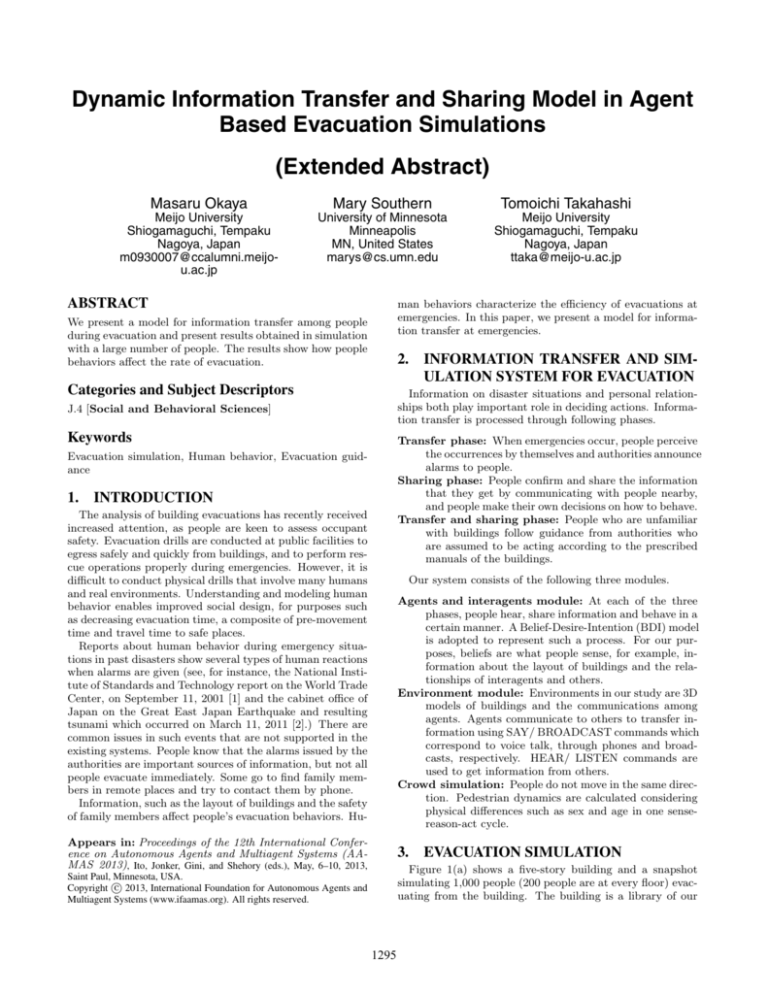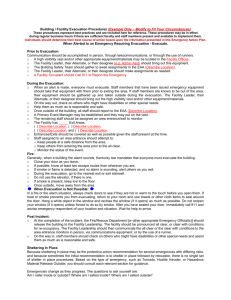
Dynamic Information Transfer and Sharing Model in Agent
Based Evacuation Simulations
(Extended Abstract)
Masaru Okaya
Mary Southern
Tomoichi Takahashi
Meijo University
Shiogamaguchi, Tempaku
Nagoya, Japan
m0930007@ccalumni.meijou.ac.jp
University of Minnesota
Minneapolis
MN, United States
marys@cs.umn.edu
Meijo University
Shiogamaguchi, Tempaku
Nagoya, Japan
ttaka@meijo-u.ac.jp
ABSTRACT
man behaviors characterize the efficiency of evacuations at
emergencies. In this paper, we present a model for information transfer at emergencies.
We present a model for information transfer among people
during evacuation and present results obtained in simulation
with a large number of people. The results show how people
behaviors affect the rate of evacuation.
2.
Categories and Subject Descriptors
INFORMATION TRANSFER AND SIMULATION SYSTEM FOR EVACUATION
Information on disaster situations and personal relationships both play important role in deciding actions. Information transfer is processed through following phases.
J.4 [Social and Behavioral Sciences]
Keywords
Transfer phase: When emergencies occur, people perceive
the occurrences by themselves and authorities announce
alarms to people.
Sharing phase: People confirm and share the information
that they get by communicating with people nearby,
and people make their own decisions on how to behave.
Transfer and sharing phase: People who are unfamiliar
with buildings follow guidance from authorities who
are assumed to be acting according to the prescribed
manuals of the buildings.
Evacuation simulation, Human behavior, Evacuation guidance
1. INTRODUCTION
The analysis of building evacuations has recently received
increased attention, as people are keen to assess occupant
safety. Evacuation drills are conducted at public facilities to
egress safely and quickly from buildings, and to perform rescue operations properly during emergencies. However, it is
difficult to conduct physical drills that involve many humans
and real environments. Understanding and modeling human
behavior enables improved social design, for purposes such
as decreasing evacuation time, a composite of pre-movement
time and travel time to safe places.
Reports about human behavior during emergency situations in past disasters show several types of human reactions
when alarms are given (see, for instance, the National Institute of Standards and Technology report on the World Trade
Center, on September 11, 2001 [1] and the cabinet office of
Japan on the Great East Japan Earthquake and resulting
tsunami which occurred on March 11, 2011 [2].) There are
common issues in such events that are not supported in the
existing systems. People know that the alarms issued by the
authorities are important sources of information, but not all
people evacuate immediately. Some go to find family members in remote places and try to contact them by phone.
Information, such as the layout of buildings and the safety
of family members affect people’s evacuation behaviors. Hu-
Our system consists of the following three modules.
Agents and interagents module: At each of the three
phases, people hear, share information and behave in a
certain manner. A Belief-Desire-Intention (BDI) model
is adopted to represent such a process. For our purposes, beliefs are what people sense, for example, information about the layout of buildings and the relationships of interagents and others.
Environment module: Environments in our study are 3D
models of buildings and the communications among
agents. Agents communicate to others to transfer information using SAY/ BROADCAST commands which
correspond to voice talk, through phones and broadcasts, respectively. HEAR/ LISTEN commands are
used to get information from others.
Crowd simulation: People do not move in the same direction. Pedestrian dynamics are calculated considering
physical differences such as sex and age in one sensereason-act cycle.
Appears in: Proceedings of the 12th International Conference on Autonomous Agents and Multiagent Systems (AAMAS 2013), Ito, Jonker, Gini, and Shehory (eds.), May, 6–10, 2013,
3. EVACUATION SIMULATION
Figure 1(a) shows a five-story building and a snapshot
simulating 1,000 people (200 people are at every floor) evacuating from the building. The building is a library of our
Saint Paul, Minnesota, USA.
c 2013, International Foundation for Autonomous Agents and
Copyright Multiagent Systems (www.ifaamas.org). All rights reserved.
1295
university that has stairs between floors and two exits. One
exit is the front exit, 3.7m wide, on the 2nd floor, and the
other is an emergency exit on the 1st floor.
People at the 1st and 2nd floors are guided to evacuate
from the exits that are connected to the floor: the front
exit and the emergency exit, respectively. For people at
the other floors, different evacuation plans are prepared to
evacuate smoothly (Table 1). Plan A is designed to ease
congestion at staircase landings where people coming from
upstairs meet people coming to the stair from the floor. Plan
B leads people in proportion to the widths of exits.
Emergency Exit
Front Exit
(Circle indicates the landing)
scenario 1
scenario 3
(a) snapshot of evacuation
scenario 2
scenario 4
(b) rate of evacuation
Figure 1: Evacuation from building
located in the library. The parent and child in 22% of pairs
are together on the same floor, and the parent and child of
the rest pairs are on different floors. As for the distribution
of by floor, 23%, 19%, 18% and 18% pairs were located at1,
2, 3, and 4, respectively (Table 2).
The child agents cannot go to the exits by themselves.
Examples of typical communications that are exchanged between parents and their child before their egress (the left
column is types of Agent Communication Language (ACL))
are as follows:
Query-Ref Where are you?
Inform
I am at location X.
Request
Stay there.
Agree
I will stay here.
Query-If
Is it safe to use the main exit?
Table 2 shows the time from the announcement to when
the parents go to their child. When the parents are at a
lower level, they go to their child at an upper floor, and
their movements are counter to the major flow of people
who are trying go down the stairs to the exit. Most of the
pairs in which the parent was at a lower level than their
child did not evacuate.
Table 2: Family movement time to get to child.
diff. of parent agent is at A or B their child
floor
A: above floor
B: below floor
4
7/48
831 ± 696 1/44
2178
3
7/36 2171 ±
87 0/54
2
4/34 2211 ±
10 0/59
1
5/58 1775 ± 496 3/57 2264 ± 87
0: at the same floor as their child, 13/110 516 ± 680.
2nd and 4th column are the number of evacuated pairs and
initial assigned pairs, respectively.
Table 1: Routes guided in phased evacuation.
building
plan A
plan B
comment
F
exit
Em. Fr. Em. Fr.
5
security office
4
3
2 front
width is 3.7m.
1 emer.
width is 1.3m.
Evacuation guidance scenarios.
4.
Four scenarios are simulated. Scenario 1 and 2 are plan
A and B, in which the evacuation guidance is announced
once at the starting step. Scenario 3 and 4 are modifications of plan B. At scenario 3, in addition to the initial
announcement, five security department staff members go
to the landing spaces of the stairs at each floor. And they
guide by giving SAY command people who stay there hear
the same initial announcement again. In scenario 4, the
guidance of the staff at 3F is that people should go out of
the building from the front exit (not the emergency exit).
Figure 1(b) shows the percentage of evacuated people. We
expected scenario 2 to be better than scenario 1 and that the
local evacuation guidance of scenario 3 would work well, because the width of the front exit is wider than the emergency
exit. What we found in simulations is that the scenario 1 was
better than scenario 2. In scenario 2, the path of the agents
heading to the emergency exit and the path of the agents
heading to front exit collide. These movements caused congestion and prevented a smooth evacuation at the landing
of 3F. In scenario 3, the guidance given from the staffs at
the landings did not produce any results. In scenario 4,
the changed guidance eased the congestion, and made for a
better evacuation rate, compared with scenario 1.
DISCUSSION AND SUMMARY
We propose an information transfer and sharing model,
which enables announcement of evacuation to people or information sharing during evacuation. In conjunction with
the BDI model and our information transfer using ACL
based communication, our simulation system 1) enables the
simulation of evacuation behaviors at various scenarios, 2)
demonstrates places where congestions may occur, and 3)
eases congestion by proper guidance.
The simulation results demonstrate that ways of guidance
can improve evacuation time, and they reveal phenomena
in agent behaviors that have not been simulated by other
methods. The results show some possibilities for evaluating
prevention plans including the ways of administering evacuation guidance.
This work was supported by JSPS KAKEN Grant Number 24500186 and The Nitto Foundation.
5.
REFERENCES
[1] J. D. Averill, D. S. Mileti, R. D. Peacock, E. D.
Kuligowski, and N. E. Groner. Occupant behavior,
egress, and emergency communications. NIST
NCSTAR 1-7, National Institute of Standards and
Technology, Gaithersburg, 2005.
[2] C. O. G. of Japan. Prevention disaster conference, the
great east japan earthquake and tsunami. Report on
evacuation behavior of people (in Japanese). 2012.
Family evacuation.
We placed 500 parent-children pairs in the library. When
the evacuation guidance was given, the pairs were randomly
1296







